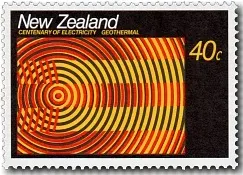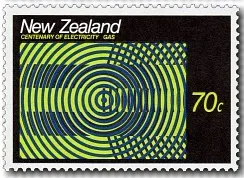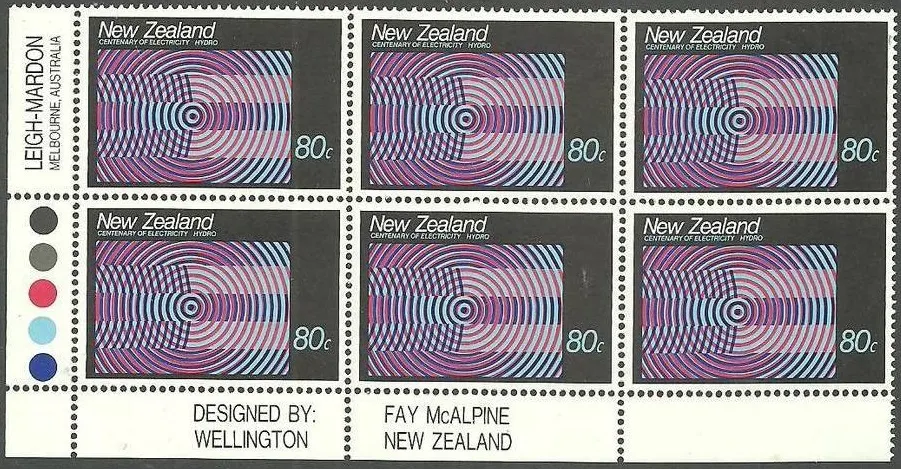
New Zealand's beginning as a nation was marked by the signing of the Treaty of Waitangi in 1840. A little more than 25 years later, the first hydro-electric power was being generated by crude installations in the goldfields of the South Island.
In 1888, one of these gold mining centres, now the town of Reefton, became the first community in the Southern Hemisphere to switch on to municipal hydro-electric power. This was only six years behind similar developments in the United States of America.
After Reefton, other pockets of private and commercial electricity generation were established throughout the country. In 1904, a detailed survey of New Zealand's power potential described the country as "the powerhouse of the Orient".
Geothermal Electricity Generation - 40c
New Zealand's active thermal area in the centre of the North Island is the result of two of the earth's crustal plates grinding together to produce earthquakes, volcanic activity, geysers, bubbling mud pools - and geothermal steam. Bores driven deeply into the earth release the pressure, the water boils and high pressure steam and water roar up the pipes. Steam and water are divided at the boreheads, with the steam piped off to spin the turbines at the generating plant. The hot water, cooling as it goes, flows into the nearby streams and river.
New Zealand's active thermal area in the centre of the North Island is the result of two of the earth's crustal plates grinding together to produce earthquakes, volcanic activity, geysers, bubbling mud pools - and geothermal steam. Bores driven deeply into the earth release the pressure, the water boils and high pressure steam and water roar up the pipes. Steam and water are divided at the boreheads, with the steam piped off to spin the turbines at the generating plant. The hot water, cooling as it goes, flows into the nearby streams and river.
Fossil Fuel Electricity Generation - 60c
The term 'thermal' applied to electricity generating stations, means that heat is used in some form to generate electricity. In hydro plants, water drives the turbine generators. Conventional thermal stations burn fuels such as coal, oil or gas to produce steam to turn the turbine generators. This method of producing electricity has proven to be the most expensive and so now most Thermal Power Stations are only used in times of peak demand.
The term 'thermal' applied to electricity generating stations, means that heat is used in some form to generate electricity. In hydro plants, water drives the turbine generators. Conventional thermal stations burn fuels such as coal, oil or gas to produce steam to turn the turbine generators. This method of producing electricity has proven to be the most expensive and so now most Thermal Power Stations are only used in times of peak demand.
Gas Electricity Generation - 70c
Compared with other types of thermal plants, gas turbines are relatively cheap and quick to build but are expensive to operate. Their main role in New Zealand is to produce electricity for short periods to cope with daily system peaks. Gas turbine plants can be run non-stop in cases of sustained low lake levels or when another plant is unavailable. Gas turbines comprise gas generators, based on jet engine design, power turbines and electric generators assembled in one line.
Compared with other types of thermal plants, gas turbines are relatively cheap and quick to build but are expensive to operate. Their main role in New Zealand is to produce electricity for short periods to cope with daily system peaks. Gas turbine plants can be run non-stop in cases of sustained low lake levels or when another plant is unavailable. Gas turbines comprise gas generators, based on jet engine design, power turbines and electric generators assembled in one line.
Hydro Electricity Generation - 80c
New Zealand's geological formation and climate were its good fortune when it came to providing electric power. Production of hydro-electricity is relatively simple. Water trapped behind a dam flows with great force down penstocks to spin the blades of a turbine. The turbine drives the generator which produces electricity. By far the cheapest power station to operate, Hydro Power Station use a renewable resource.
New Zealand's geological formation and climate were its good fortune when it came to providing electric power. Production of hydro-electricity is relatively simple. Water trapped behind a dam flows with great force down penstocks to spin the blades of a turbine. The turbine drives the generator which produces electricity. By far the cheapest power station to operate, Hydro Power Station use a renewable resource.
Plate Blocks.
Notice each of these blocks carries the designer, the printer and printer's colour tags.
Below is the First Day Cover.
Dawson's Hotel was one of the early hotels to be powered by electricity.
Two perforation errors.
Notice in each case the perforation has moved to the left so part of the stamp's design
runs off the right-hand side.
Now while we are talking about electricity, lets look at one of the developments that came from a steady supply of electric power. In 1988 the electrification of the North Island Main Trunk Railway was completed. To mark this event, this special cover was produced. Below the cover is a detail of the electric locomotive used on the N.I.M.T.
Some of the images in this post were used with permission from the illustrated catalogue of StampsNZYou can visit their web site and On-line Catalogue at, http://stampsnz.com/












We appreciate your engagement with our content. To ensure a respectful and constructive community, please take note of the following:
- No Spam, Please: We do not tolerate spammy or promotional comments. Any such comments will be promptly removed.
- Moderation in Place: All comments are moderated to maintain a positive and inclusive environment. Please be patient, as it may take a little time for your comment to appear.
- Sign In with Google: To comment, please sign in using your Google account. This helps us maintain the integrity of our community and allows for better interaction.